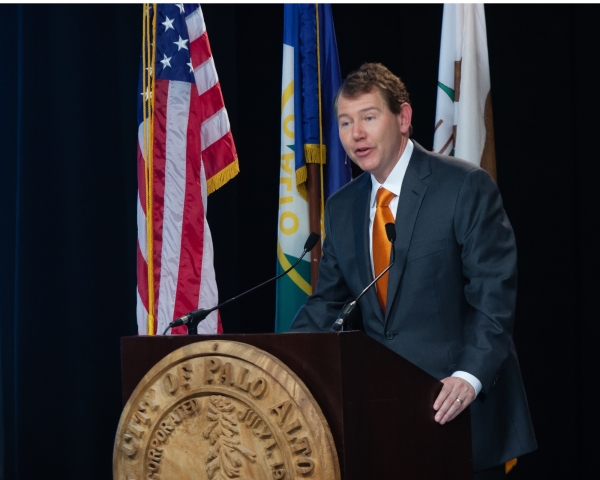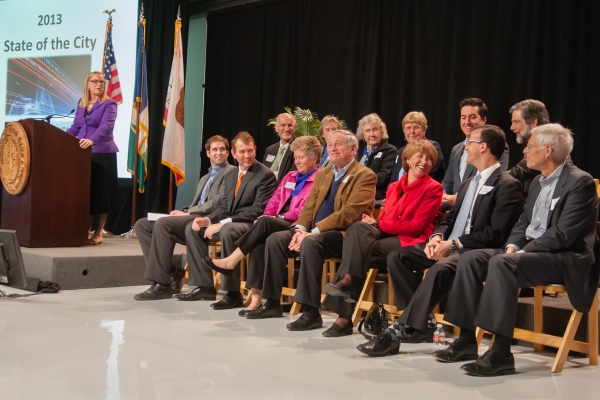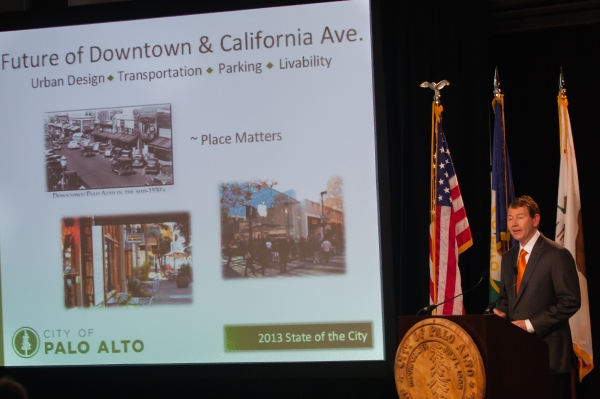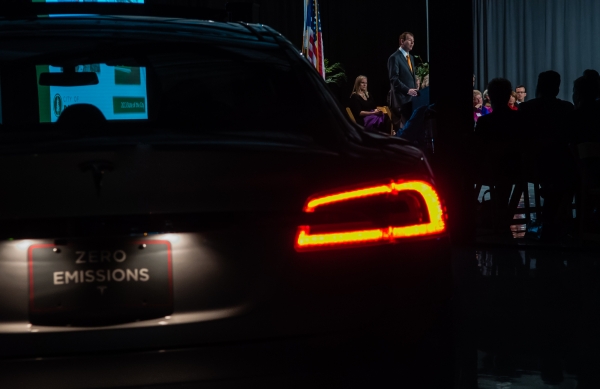Calling Palo Alto a place where the "future continues to be invented," Mayor Greg Scharff rolled out on Wednesday night a broad and ambitious agenda for the coming year, including plans to bring wireless Internet service to local parks, add parking garages to downtown and institute smoking restrictions in open-space preserves.
In a "State of the City" speech presented at the headquarters of Tesla Motors, Scharff recapped the city's recent accomplishments, detailed the city's official 2013 priorities and made a few proposals of his own, including requiring developers to pitch in more funds for public art and reviving the city's recently stalled effort to bring ultra-high-speed Internet to the masses.
Calling the coming year "Lucky '13" and referring to it as the "Year of the Future," Scharff told the assembled crowd of about 100 that they have much to be proud of and look forward to. Palo Alto, he said, is "the birthplace, the creative center, the heart, the essence of Silicon Valley" and "the innovation capital of the world."
"The ideas that change the world start here," Scharff said. "In a garage, or in a coffee house, in our homes, or offices, the future continues to be invented here in Palo Alto."
While his speech celebrated many of the city's recent achievements, it also offered a host of new proposals for the City Council to debate in the coming year. Some, like the proposals to construct a public-safety building, expand the city's biking amenities, and determine the future of Cubberley Community Center in south Palo Alto, have been on the council's agenda for several years now and are slated to get closer to resolution this year. Others are new and are yet to be vetted by the council and the community at large.
Among the new ideas are Scharff's proposal to expand the city's existing "One Percent for Art" program -- which requires developers to allot 1 percent of a project's construction budget for acquiring public art -- to encompass private as well as public capital projects (currently, it applies to only to public projects); his plan to bring Wi-Fi to local parks, starting with Cogswell Plaza in downtown Palo Alto; and a proposal to bring buildings on University Avenue into conformance with zoning laws that require retail on the ground floor.
Scharff also said the council will consider banning smoking at three downtown parks: Lytton Plaza, Cogswell Plaza and Sara Wallis Park. After that, he said, the city will explore "a much broader ban on smoking in all parks and open space in Palo Alto."
"Palo Alto has fallen behind other cities in restricting smoking," Scharff said. "Second-hand smoke, as everyone knows, not only is a huge quality of life issue, it kills you."
In recommending the expansion of the "Percent for Art" policy, he said that Palo Alto also trails other cities "in fostering public art and providing a dedicated funding source for maintenance of our public art collection." Scharff also said the city should have a dedicated funding source for maintenance and administration of the city's art collection.
Scharff's speech also covered the three priorities that the council adopted earlier this month at its annual retreat: infrastructure, the future of downtown and technology.
The speech detailed a list of proposals to strengthen downtown. The most ambitious and -- at least from the perspective of downtown residents -- urgent of these is adding parking. This means both building new garages and closing loopholes in the zoning laws to make sure that new downtown developments don't make the existing parking shortage any worse, Scharff said.
"All new projects now will have to provide parking for their ground floor office or retail space. We need to stop granting transfer development rights that allow developers to build without parking," Scharff said. "We must ensure that all new buildings are either fully 'parked' or pay the full cost parking space into the parking fund."
Scharff also highlighted the council's recent efforts to encourage downtown retail, including a proposal to require ground-floor retail on the 600 block of Emerson Street, a peripheral downtown block where the retail space in several buildings recently switched to more financially lucrative office space.
The city's second-most prominent commercial thoroughfare, California Avenue, will see more immediate and dramatic changes this year. This fall, the long-planned and controversial renovation of the eclectic and worn strip will finally begin. The streetscape project includes a reduction of lanes from four to two, wider sidewalks, new public plazas and new street furniture.
"California Avenue will rival Castro Street when it is completed," Scharff said, citing Mountain View's popular downtown thoroughfare.
On the infrastructure front, Scharff picked up where former Mayor Yiaway Yeh left off last year. Yeh had labeled 2012 the "Year of Infrastructure Renewal and Investment" and Scharff's speech, much like the council's official priority list, underscored the fact that this priority will extend into 2013 and beyond. Scharff cited the city's recent steps, including a decision to add $2.2 million annual for capital improvements and alluded to the council's ongoing work to determine whether to put an infrastructure measure on the 2013 ballot. The multi-year effort, he said, "will catch up on deferrals of our past, keep pace with the demands of today and invest in our future." This includes the city's ongoing search for a new police headquarters, a project Scharff acknowledged he wasn't excited about before but now sees as urgent.
In addition to these overdue fixes, the city is also proceeding with ambitious new projects, including building a bike bridge over U.S. Highway 101 and a major renovation of the Palo Alto Municipal Golf Course, a project that is part of the regional effort to improve flood protection around the San Francisquito Creek. In addition to reconfiguring the golf course, the project will make space for three athletic fields on the Baylands course.
A thornier subject on the infrastructure front is Cubberley Community Center, a much valued but dilapidated hub in south Palo Alto that the city shares with the school district. With the city's lease of Cubberley space set to expire next year, Scharff said a "master plan needs to be developed now." School and city officials met for much of the past year to consider the future of the community center.
"I envision that this year we will rise to the challenge as a community to develop a plan now for Cubberley that gives the school district flexibility while creating a first-rate community center in south Palo Alto," Scharff said. "We must not give in and kick the can down the road to some future council while Cubberley rots in place."
Technology, another council priority, also featured prominently in Scharff's speech. Palo Alto, he said, "should be the leading digital city of the future." He cited recent accomplishments, including last year's Hackathon event, which received national attention, and the city's unveiling last year of an Open Data platform that posts raw data on such topics as libraries and building permits on the city's website so that programmers can create applications based on them. Future projects that he cited in his speech include more Wi-Fi spots, a "Palo Alto 311" help line and a variety of apps, some of which would presumably be built by citizen entrepreneurs.
Perhaps the grandest and longest pursued technological endeavor is "Fiber to the Premises," a stalled effort that the city has explored for more than a decade. The project entails using the city's existing dark-fiber ring to bring ultra-high-speed Internet to all residents. While this proposal largely fizzled last year, when staff recommended scrapping it, Scharff proposed on Wednesday that the city bring it back.
"Over the years, several plans were developed but not implemented, for a variety of reasons," Scharff said. "Ultra-high-speed Internet has been a Palo Alto vision for a long time. Now is the time to fulfill that vision."
Scharff's speech stood out from recent "State of the City" presentations both for the range of its proposals and for its location. For the third straight year, the city held the annual event away from City Hall. While the last two speeches were presented at prominent and highly visible locations -- Cubberley Community Center in 2011 and the Oshman Family Jewish Community Center last year -- Wednesday's speech took place in the relatively secluded Tesla's headquarters in Stanford Research Park. This meant a smaller crowd, fancier catering and two Tesla Roadsters on prominent display at the company's warehouse, which functioned as an auditorium for the evening.
Scharff was introduced by JB Straubel, Tesla's chief technical officer, who talked about the company's decision to move its headquarters to Palo Alto in 2009. What sets the city apart, Straubel said, is the people who foster the city's culture of innovation.
"The quality of the people, the general breadth of education, the openness and the insights and the attitudes are so unique," Straubel said in his introductory remarks.






Comments
Community Center
on Feb 28, 2013 at 1:58 am
on Feb 28, 2013 at 1:58 am
Congratulations to Mayor Scharff for his visionary proactive speech. It's going to be an exciting year!
College Terrace
on Feb 28, 2013 at 2:21 am
on Feb 28, 2013 at 2:21 am
Do you know there is a public city park in Palo Alto where non-Palo-Altoans are not allowed?
That's right. In Foothills Park on page mill road, I actually saw a sign that said so.
Wow! What an elitist attitude. Imagine if Mountain View suddenly decided to ban just Palo-Altoans from Shoreline park... Wouldn't blame them a bit.
Another Palo Alto neighborhood
on Feb 28, 2013 at 7:39 am
on Feb 28, 2013 at 7:39 am
WiFi to all city parks? Where did that one come from?
David, Foothill is well known and there are historical reasons for this. Just enjoy it if you are a PA resident. (I am not saying I agree with the historical reasoning, just that it is a bigger issue than you think).
Community Center
on Feb 28, 2013 at 7:42 am
on Feb 28, 2013 at 7:42 am
"future continues to be wasteful". He said it right!
Another Palo Alto neighborhood
on Feb 28, 2013 at 10:51 am
on Feb 28, 2013 at 10:51 am
Every year we (the residents, property owners and business owners) hear this same silliness. What about all of the visions from the previous five years of Mayoral addresses/promises? What happened to those plans?
The article mentions the “Hackathons” that drew some media attention at the time. What has ever come of these efforts? Has anything of much value appeared in the toolkit of local government, delivered via the City’s web-site, which can validate the ideas that lead to these media events?
It’s really hard to see anything of value! Just a lot of hype, and a few names in the papers for some of the participants.
Greg Scharff’s plans are hardly “bold”, since they have all been suggested before—in any number of venues. It’s also not clear where the funding for any of these ideas will come from—something that “da mayor” seems to have overlooked when he took the podium at the private sector Tesla Corporation headquarters.
It would be really interesting to find out whose idea that was. Of course, it could have been in Jim Baer’s office … with the attendees being a limited number of “family and friends” of “da mayor”.
Evergreen Park
on Feb 28, 2013 at 11:58 am
on Feb 28, 2013 at 11:58 am
Scharff was introduced by JB Straubel, Tesla's chief technical officer..
No doubt about it anymore, there's a fancy car in Mr. Scharff's future. Like George Bush, his alliance with the private sector enriched them both. Bush frequently sold off public land. Mr Scharff has a slightly different plan. Publicity, and more. We'll see.
Instead of percent for art, how about % for street repair?
Duveneck/St. Francis
on Feb 28, 2013 at 1:14 pm
on Feb 28, 2013 at 1:14 pm
Nice comments on handing parking for new development.
Did he address crime at all other than wanting a new public safety building?
College Terrace
on Feb 28, 2013 at 2:28 pm
on Feb 28, 2013 at 2:28 pm
"...efforts to encourage downtown retail." - retail is lacking downtown? News to me.
Parking is a problem downtown? So what? Just price it accordingly.
1% to Art for private projects now also? I think pretty much every piece of public art in PA is, to put it mildly, crap. The only good ones are aliens painted on the sides of buildings. 1% of total development cost is a large sum to developers, and will negatively impact many other features of a given development. For instance, design, accessibility, size, "public benefits" (which I also have problems with). Seems like more extortion. Along with upped parking requirements.
Also - "Year of the Future"...? That is one of the biggest oxymorons I have ever read. Why can't we have a "Year of getting normal things done efficiently"??
Community Center
on Feb 28, 2013 at 4:31 pm
on Feb 28, 2013 at 4:31 pm
Folks, lighten up and be more optimistic. Smile[:-)
Another Palo Alto neighborhood
on Feb 28, 2013 at 6:39 pm
on Feb 28, 2013 at 6:39 pm
The State of the City is a mess.
Mitchell Park library - big unfinished mess.
Edgewood Plaza - big unfinished mess.
Soon the drug dealers, the homeless and squatters will move in and that will be another big political excuse to stop work.
Goal for the year - finish every single project around town before starting on anything new.
Pay for infrastructure and put everything else on the ballot to see if we are willing to pay for it.
Get something done around here already!
Downtown North
on Feb 28, 2013 at 7:15 pm
on Feb 28, 2013 at 7:15 pm
The mayor wants to attract more high tech businesses to PA, and other unrealistic stuff that should not have priority at this time. Just as I thought, he does not want to deal with all the important and necessary issues that are urgent, such as bldgs behind schedule and over budget, crumbling bridges, flooding, traffic, potholes, etc. they are not glamorous like WIFI in the park ( I do not think that is what parks and playgrounds are for, buddy) or Manhattanization. He is from another planet or totally out of touch or both.
Community Center
on Feb 28, 2013 at 10:33 pm
on Feb 28, 2013 at 10:33 pm
At the end of February the mayor outlines his vision? That iis two months gone by. Typical self serving drivel. The weekly should have provided more balanced reporting. Gennady has already written a fluff piece on Scharf and obviously thinks the sun rises and sets with him.
Not surprised to see one of the city insiders heading up the cheer leading on this thread.
Midtown
on Mar 1, 2013 at 7:01 am
on Mar 1, 2013 at 7:01 am
The Mayors state of the City is traditionally at the end of February. @ out of touch. Scharff spent a lot of his speech talking about infrastructure, crumbling buildings, fixing cubberley, resolving the flooding issue, fixing the streets. @resident he also addressed at length Mitchell Park library and infrastructure.
Embarcadero Oaks/Leland
on Mar 1, 2013 at 11:17 am
on Mar 1, 2013 at 11:17 am
And Be Fair also consider that the vision and rhetoric has been rarely backed up with any real follow through and results. We have been faced with annual budget deficits for many years running. We have vital and essential needs in infrastructure and public safety that have been pushed aside and dismissed. We have no financial plan or means of paying for those needs, and the only solution that our city leaders have proposed is yet another bond measure and tax increase.
In my opinion our city leaders have been highly irresponsible. They have shown no sense of setting and following through with sensible financial priorities. They decry the ongoing budget deficit, and lament this unprecedented financial crisis, but yet continue to spend on non-essential, feel good, niche projects and services. Whenever reasonable cuts are proposed, or certain city services are discussed at being outsourced, our city leaders buckle to the pressure of the special interests and vocal minorities and allow themselves to be shouted down. No courage. No leadership. No one willing to make the tough decisions that would ultimately serve the greater good.
Rather than apply some common sense measures toward fiscal responsibility, the best our city leaders can come up with is another tax increase. Absolutely unreal. As Palo Alto citizens and tax payers we cannot let them off the hook. They cannot be allowed to return to the public trough crying poor. Not after they have and continue to spend millions of public dollars on non-essential fluff like bike bridges, new playgrounds, dog parks, public art, community center facelifts, commercial zone beautification, golf course developments, as well as continuing to fund programs such as the Children's Theater and Opportunity Center.
Crescent Park
on Mar 1, 2013 at 12:30 pm
on Mar 1, 2013 at 12:30 pm
@ David: I'm guessing you're relatively new to the area and don't know the history behind Foothills park. Do some Googling and you'll get what went on many years ago and why the residential status is required. Hint: It's all about the money, not the attitude.
Fairmeadow
on Mar 1, 2013 at 2:17 pm
on Mar 1, 2013 at 2:17 pm
Gregg Scharff’s suggestion to have WiFi installed in Palo Alto parks is a partial solution to a bigger problem. What is needed is a city-wide WiFi network (often called a Mesh Network)--like the one that Google installed in Mountain View. This idea was championed by a group called Wireless Silicon Valley (or some such), but that group’s management was unable to bring the plan to fruition.
The cost for each node in this sort of network is generally less than $1000. The long-term cost for electricity, maintenance, and Internet access is known only to Google. However, if Mountain View continues this system when Google’s support ends, then this operation cost would be a matter of public record.
Comments like “parks are not for WiFi” seem more than misguided in this day and age. Wireless signals are everywhere. Many Cell Phones are now “off loading” their message, and data traffic, to local WiFi hotspots. This traffic is not charged like the 4G traffic is—giving the end user a cost savings. Moreover, Cell Phones are needed for public safety, and most certainly should be carried by people wherever they go, including iparks. To suggest that people should not be permitted to use their Cell Phones, iPads/iPods in public spaces (like parks) is a bit frightening—since parks should be about personal freedom. As long as one person is not bother another, why shouldn’t people be able to download music and listen to it via a public WiFi link?
This idea has been submitted to the City a number of times—and soundly rejected by Staff, in the past. If Scharff is claiming that he is the first person to come up with this idea—he would not be telling the truth. Sadly, the public process is somewhat muddied in this town so that good ideas are often rejected without any kind of airing--that would help clarify their value, and cost.
Seeking contributions from local businesses would help to pay for the initial purchase of this equipment. The long-term costs would likely be minimal, although it would pay for someone to actually “run the numbers” agreeing to this project—since it’s possible that some of the locations where nodes might be needed could be off the power grid, requiring significant costs to provide power and network access. One would have thought that helping to introduce leading-edge technology by contributing funds, or expertise, is that one of the things a Chamber-of-Commerce in the middle of the Silicon Valley would have done long ago.
The world is embracing wireless data transmission. The City of Palo Alto needs to recognize that fact, stop flogging dated ideas like municipal-owned Fiber-to-the-Premises networks, looking instead to the application of wireless based technologies to deliver City services, as well as distribute information of a public nature.